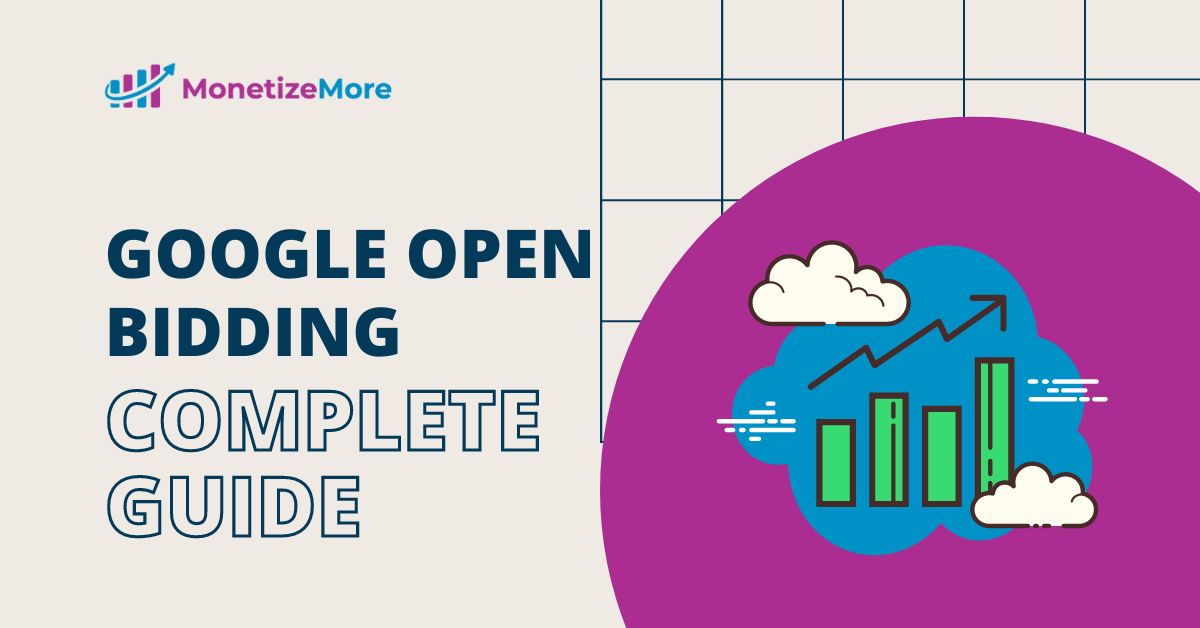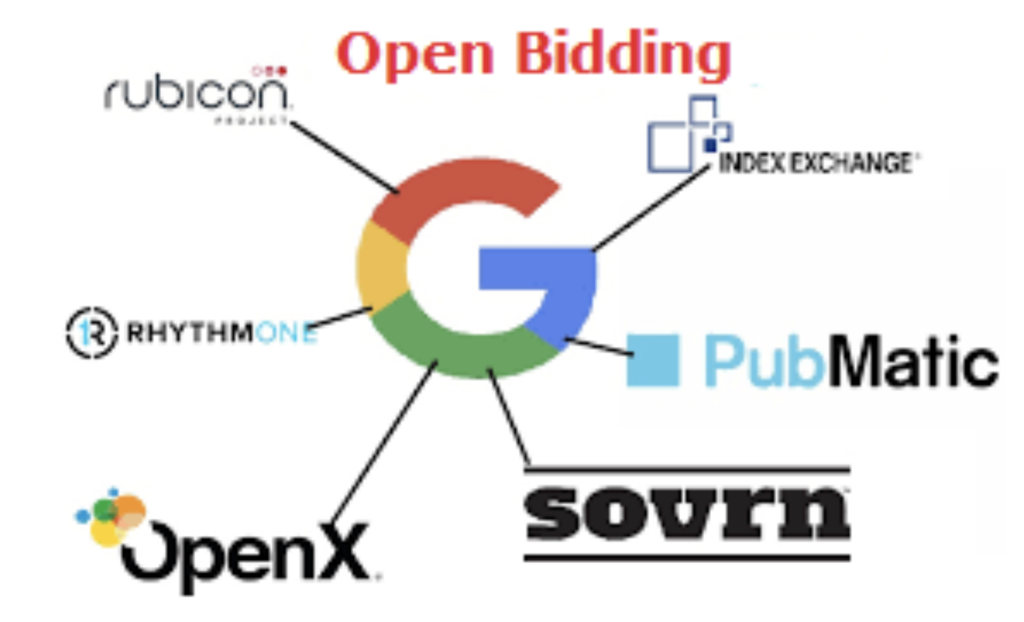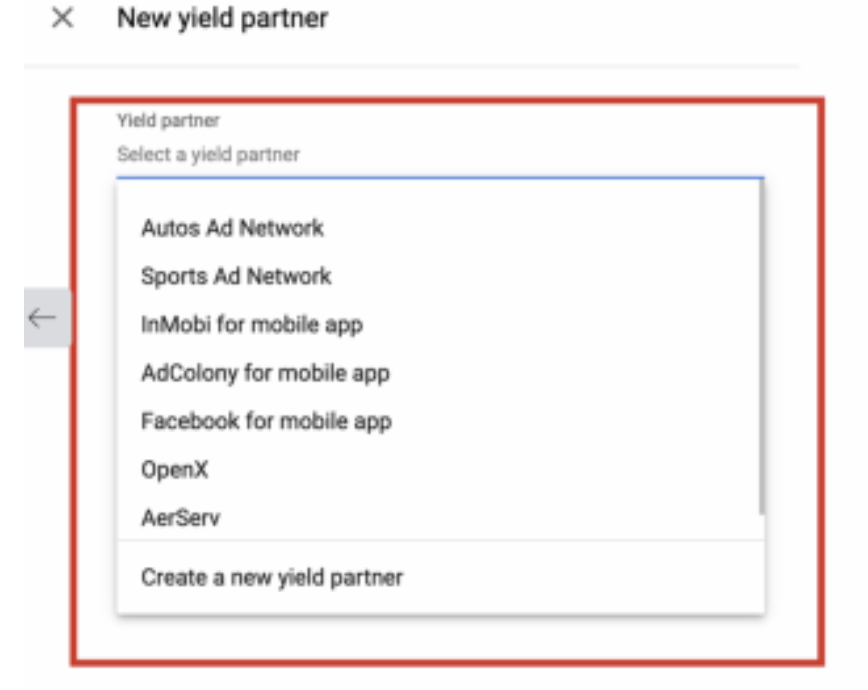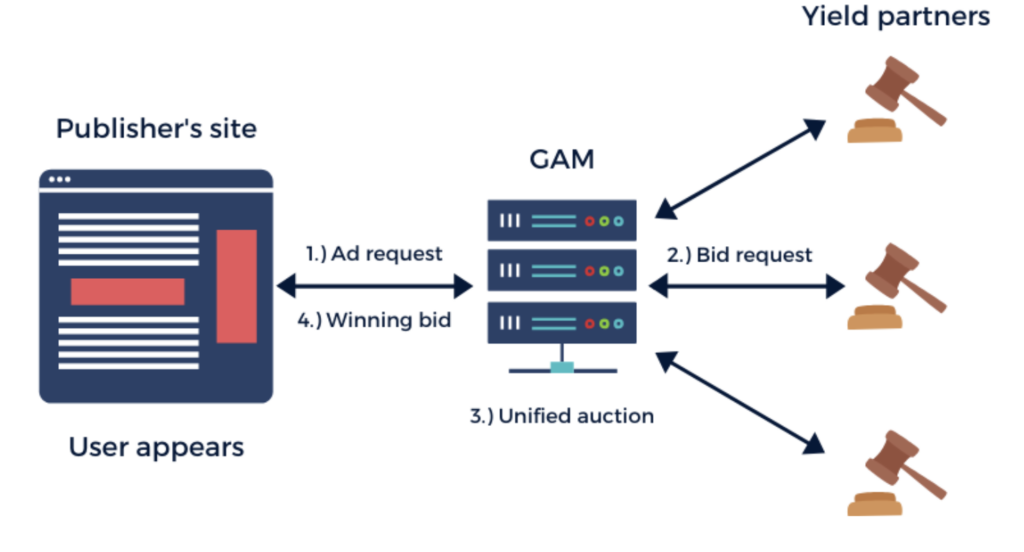
This post was most recently updated on January 18th, 2023
If you have an app and haven’t tried out Google Open Bidding yet, you are missing out on a lot of ad earnings. Open Bidding was earlier known as Exchange Bidder in Dynamic Allocation (EBDA).
Google OpenBidding is an ad exchange that lets publishers invite demand partners (ad networks) to a unified, server-to-server auction so that they can start bidding for impressions on their sites. Open Bidding comes with granular reporting and billing and publishers with Google Ad Manager (GAM) set up can get started with Open Bidding right away.
This guide breaks down all you need to know about Open Bidding so that you don’t mix it up with header bidding. Stay tuned!
OpenBidding is Google’s latest alternative to header bidding. It is a server-side unified auction that publishers can access through GAM’s automated bidding platform. With Open Bidding, publishers can invite demand partners/yield partners like ad networks and ad exchanges to bid for their ad inventory in real-time.
Publishers can choose to allow their ads to be displayed on Open Bids, allowing them to receive revenue from all of the ads shown on the platform. It allows publishers to integrate non-Google Demand Partners and reduces page load times. Header bidding runs on a user’s browser while Open Bidding runs on an ad server, making it easier for the user’s device to load the overall ad setup.
This means the page loads faster, resulting in better Core Web Vitals scores. However, Open Bidding also delivers a lower yield because cookie matching on this platform isn’t effective enough if you compare Ad RPMs to header bidding.
With Open Bidding, publishers can choose from multiple yield partners who bid for their inventory. As a result, they should see a higher ad-fill rate and eCPM than if they were using Google Ad Exchange alone.

The ad networks & ad exchanges that have a contract with Google to take part as an open bidder are the main yield partners. Publishers that want to allow a yield partner to bid on their inventory need to have a contractual agreement. Google merely offers a platform for publishers to host auctions on GAM and doesn’t facilitate this contractual relationship between publishers and open bidders. Publishers can access Index exchange omnichannel demand by enabling Index in Google AdMob & GAM.

Google Ad Manager allows publishers to manage their ad inventory across multiple platforms & facilitates open bidding requests with their demand partners.
Publishers can create a GAM account and link it to their Google Ad Exchange (Adx) account. Once a publisher has linked their account, they can then accept bids from advertisers.
Advertisers can bid on keywords, locations, devices, and time periods. GAM allocates demand partners into yield groups that compete against one another once a request is accepted by a demand partner.
The process starts with a user visiting a website. When they visit the site, a cookie is placed on their device. This cookie contains information about the user, including their location, age, gender, interests, and other demographic information. This information is passed to GAM through the Google Publisher Tag and Google AdMob SDKs. GAM translates the data into bid requests and sends them to the demand partners.

Google Ad Manager hosts unified auctions so that publishers get the highest yield. The unified auction consists mainly of the yield partner bids and an ad exchange bid. Other direct line items are inserted through dynamic allocation.
GAM simultaneously does several tasks to achieve that goal:
Google Ad Manager 360 users can only access Open Bidding, preventing many publishers from leveraging it. You can access Google Open Bidding by getting in touch with us today since we’ve been facilitating Open Bidding, direct deals and programmatic deals for a decade.
How it works:
In Open Bidding, GAM invites demand partners to be involved in the process to get increased yield. With Google AdSense, buyers bid for ad inventory depending on the publisher’s target audience. Open Bidding is limited to Google Ad Manager 360 users while AdSense is available for all publishers.
With Open Bidding, publishers also get benefits like higher eCPMs, more revenue, and unified auctions compared to AdSense. Unified auctions include SSPs, ad networks, & multiple exchanges. SInce multiple ad networks bid on a publisher’s inventory, its a win-win situation for publishers when it comes to using Open Bidding over Google AdSense.
Open Bidding was Google’s answer to Header Bidding Lite with improved site speed/ page load speed.
Header bidding launched with a client-side setup where auctions run on the user’s browser. Looking at the latency issues it can cause, server-side setup was introduced. Since Google had this data before starting with Open Bidding, it directly went for server-side auction.
Although server-side Open Bidding demand partners cannot access the same cookie information as client-side header bidding demand partners. This is the reason why media buyers bid less with Open Bidding due to lack of accuracy in targeting when comparing it to Header Bidding’s targeting accuracy.
In Open Bidding, since ad auctions take place in the background, there’s less page loading latency. Usually, the ad requests timeout if it crosses 160 milliseconds. Additionally, its simplistic and granular reporting lets publishers determine revenue generating streams & best demand partner relationships.
Users with limited technical skills will enjoy the simplicity of OpenBidding while publishers using header bidding need advanced technical expertise in web development.
With header bidding, publishers can see incoming bid prices and bids. With this level of transparency, they get to see how the winning bids get selected & can verify the highest bids are winning fairly.
Open Bidding isn’t that transparent as it doesn’t show how the unified auction works. It does show the demand partners that are contributing to the publisher’s ad RPMs in the report but there’s no detailed breakdown of the same.
Header Bidding trumps Open Bidding when it comes to cookie matching. It leverages cookie matching to achieve the best match rate resulting in improved eCPMs.
Open Bidding does a decent job when it comes to mapping users across platforms but has no access to all the cookie data that you get with header bidding. The eCPMs are a bit lower in this case.
https://www.youtube.com/watch?v=VW42HtiMG30&feature=emb_title
Google pays out on a NET30 payment schedule (AdSense and Open Bidding included) & payments are calculated based on GAM reporting.
Managing header bidder payments for certain demand partners is extremely complicated and some ad tech companies take more than 60 days to payout. MonetizeMore is the only header bidding ad tech company that provides Advance Payments to publishers. Learn more here.
Open Bidding impressions payments are made net of Google’s gross revenue share. The Open Bidding contract addendum and the Ad Exchange agreement specify how publishers will be paid.
The publisher will receive an itemized bill from Google that displays revenue from third-party exchanges & AdX separately. They can use the yield group dimensions and metrics of GAM reporting to further itemize revenue by yield group.
When it comes to implementation, Header Bidding is quite intricate compared to Open Bidding. If you are fed up of latency, its best to try out Open Bidding.
Here’s why:
Yes! You can get the best of both worlds by combining both these auctions as the server-side & client-side auctions run separately. This auction then becomes Hybrid Header Bidding as publishers are running both client-side and server-side header bidding together.
Publishers can maximize ad earnings by leveraging their auction efficiency and performance.
How can you make this work?
As the two auctions run independently, configuring and monitoring this setup can get complicated but they are way better than the traditional waterfall method.
If you have pre-existing relationships with a number of demand sources, you can approach them and ask about Open Bidding. If not, MonetizeMore has agreements with a number of high-quality demand sources, so when partnering with us you would not need to approach the demand sources directly.
Yield partners are ad networks in Google Ad Manager. They are mainly used for app mediation or Google Open Bidding.
Yield groups let you specify which inventory you wish to sell through Ad Exchange, Open Bidding, or app mediation. It is always possible to add third-party exchanges and ad networks to yield groups.
Google facilitates all payments based on each Open Bidding yield partner's impression delivery volume. The publisher is paid and the buyer is asked to pay within 30 days by the end of the month.
Open Bidding is similar to header bidding in that it allows invited and approved third party demand sources to bid on your inventory in real time. It is handled by the Google Ad Manager server, which requests a bid from each demand source upon receipt of an ad request. Again like header bidding, publishers and demand sources form a contractual relationship beforehand. Once that is in place, Ad Manager will facilitate the bidding.
Traditional header bidding requires a complex custom code to be added to your website, increasing page load time. This can lead to a poorer user experience and also lower revenues if ads don’t load in time. MonetizeMore recognised that and our custom implementation is lightning fast when compared to other header bidding setups so if you’re partnering with us, header bidding is just as quick as open bidding.
Traditional header bidding has quite a steep learning curve, whereas Open Bidding can be handled from within the Ad Manager interface. Again, if you’re working with MonetizeMore, we do all the hard work as we have done for hundreds of publishers already. Integration is simple and fast.

With over ten years at the forefront of programmatic advertising, Aleesha Jacob is a renowned Ad-Tech expert, blending innovative strategies with cutting-edge technology. Her insights have reshaped programmatic advertising, leading to groundbreaking campaigns and 10X ROI increases for publishers and global brands. She believes in setting new standards in dynamic ad targeting and optimization.
10X your ad revenue with our award-winning solutions.